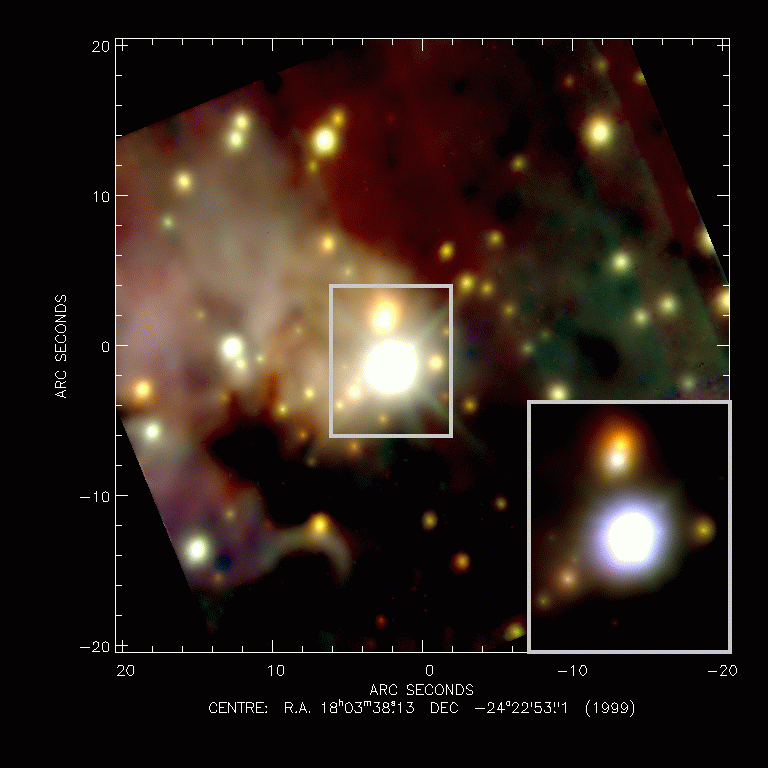| ALFA's View of the Lagoon Nebula:
|

|
| For better reproduction, it may be helpful to download the image and view it externally.
|
| Star formation in the Lagoon Nebula:
| Her 36, the bright star in image center in which the AO system was locked, is the most massive member of the star cluster NGC 6523. the stellar density in there is comparable to that inside the Trapezium cluster in Orion. Strong winds and ionizing radiation from the surface of Her 36 interact strongly with the ambient medium, creating a "blister" type HII region. The blister is clearly visible in the image: The uplit cavity in the western half is owing to Her 36's radiation. Lanes of dust stretch into this area with irregularly formed towers at their ends, visible immediately to the left of the central box. From these towers, specks of dust seem to rise from these towers into the cavity like clouds of smoke from a fire.
The ionization manifests itself in intense radio-emission from the cavity, centered on the ultracompact HII region (UCHII) G5.97-1.17. In this image, it is seen as a rather inconspicuous source, 2.7" to the south-east (lower left) of Her 36. Together with ionization structures seen on HST images, it lead to the conclusion that G5.97 is not a classical UCHII, but merely the circumstellar disk of a medium mass young star, which is externally ionized by Her 36. In the enlargement box of the image, G5.97 also looks asymmetrical with an extended Halo towqards Her36. Whether this comes from the externally heated envelope or merely from remaining static aberrations is hard to tell. This demonstrates a general problem of AO observations when it comes to the resolution limit: Remaining aberration on the scale of the diffraction limit may mislead interpretation of the data and theit changing structure across the field hinder a comparison with "standard" PSFs.
|
|
|
| Image quality:
| The data were taken during the May 99 technical run of ALFA. The image is composite of three frames taken in J, H, and K'. Each of the colour slices is in turn a combination of 4 dithered frames, each taken at different position on the sky to construct and subtract the sky background. Single frames had an integration time of 1 minute each, thus a total of 4 minutes per band was achieved. This comparatively short integration time leads to a low SNR in the raw data, the image shown here was therefore subject to a multiscale maximum entropy filtering as described by Pantin & Starck (A&AS 118, 575; 1996). At the time of the observations, the target was only 28o above the horizon. The open loop H-band image indicates a seeing of 1.1" at that wavelength.
After combination of the dithering pattern, the Strehl ratio is 22% in K' , 15% in H, and only 4% in J. One has to keep in mind however, that due to the diffuse background and the high stellar density, the Strehl ratio is hard to measure from the image and is likely to be underestimated. Difraction rings are rarely seen in the image, even inside the enlargement box. This is due to their different sizes in K' and H and because there are none at all in J.
|
|
|
| Some References:
|
- Allen D.A., 1986, MNRAS 219, 35 (on the star cluster)
- Stecklum B., et al., 1998, AJ 115, 767 (on G5.97-1.17)
- STScI Press Release PR 96-38 (on HST images)
- Woodward C.E., et al., 1986, AJ 91, 870 (on star formation in M8)
|
|
|
| For more information please contact: Markus Feldt, May 99
|
